Focusing on the basic principles of semiconductor photocatalysis, this book also gives a brief introduction to photochemistry, photoelectrochemistry, and homogeneous photocatalysis. In addition, the author — one of the leading authorities in the field — presents important environmental and practical aspects.
A valuable, one-stop source for all chemists, material scientists, and physicists working in this area, as well as novice researchers entering semiconductor photocatalysis.
Содержание
Preface XI
Acknowledgments XIII
1 Introduction 1
1.1 A Brief History of Photochemistry 1
1.2 Catalysis, Photochemistry, and Photocatalysis 5
2 Molecular Photochemistry 9
2.1 Absorption and Emission 9
2.2 Intensity of Electronic Transitions 14
2.2.1 Contribution of Nuclei 14
2.2.2 Contribution of Spin 17
2.2.3 Contribution of Orbitals 17
2.3 Excited States Radiative Lifetimes 17
2.4 Energy and Electron Transfer 19
2.4.1 Energy Transfer 19
2.4.2 Electron Transfer 21
2.5 Proton Transfer and Hydrogen Abstraction 23
2.6 Photosensitization 23
2.7 Rates and Quantum Yields 25
2.8 Quenching of Excited States 26
2.8.1 Identification of the Reactive Excited State 28
2.9 Absorption, Emission, and Excitation Spectra 28
2.10 Classification and Reactivity of Excited States 30
2.10.1 Organic Molecules 30
2.10.1.1 π, π* States 30
2.10.1.2 n, π* States 30
2.10.1.3 Charge-Transfer (CT) States 32
2.10.1.4 Triplet and Singlet Oxygen Reactions 36
2.10.2 Inorganic and Organometallic Complexes 38
2.10.2.1 Metal-Centered (MC) States 39
2.10.2.2 Ligand-Centered (LC) States 42
2.10.2.3 Charge Transfer Metal to Ligand (CTML) States 42
2.10.2.4 Charge Transfer Ligand to Metal (CTLM) States 42
2.10.2.5 Charge Transfer to Solvent (CTTS) States 43
2.10.2.6 Intervalence Transfer (IT) States 43
3 Molecular Photocatalysis 47
3.1 Hydrogenation of 1, 3-Dienes 47
3.2 Co-Cyclization of Alkynes with Nitriles 47
3.3 Enantioselective Trifluoromethylation of Aldehydes 48
3.4 Photoinduced Electron Transfer Catalysis 50
3.5 Reduction and Oxidation of Water 51
4 Photoelectrochemistry 55
4.1 Electronic Structure and Nature of Excited States 55
4.1.1 The (Optical) Bandgap 55
4.1.1.1 Measurement of the Bandgap Energy 58
4.1.1.2 Influence of Crystal Size 63
4.1.2 The Photonic Bandgap 64
4.1.3 Emission Spectra 65
4.2 Photocorrosion 68
4.3 Interfacial Electron Transfer 70
4.3.1 Introduction 70
4.3.2 Thermal Interfacial Electron Transfer (IFET) 73
4.3.2.1 IFET at the Metal/Liquid Interface 73
4.3.2.2 IFET at the Semiconductor/Liquid Interface 76
4.3.3 Photochemical Interfacial Electron Transfer 78
4.3.3.1 IFET in Large Semiconductor Crystals 78
4.3.3.2 IFET in Small Semiconductor Crystals 82
5 Semiconductor Photocatalysis 85
5.1 Mechanisms, Kinetics, and Adsorption 85
5.1.1 General Classification of Reactions 85
5.1.2 Rates, Quantum Yields, and Their Comparability 91
5.1.2.1 Direct Semiconductor Photocatalysis 91
5.1.3 Influence of Semiconductor Nature and Particle Size on Chemical Selectivity 108
5.1.3.1 Control of Chemoselectivity by Surface States and Redox Amplification 110
5.2 Characterization of Photocatalysts 111
5.2.1 General Methods 111
5.2.2 Flatband and Quasi-Fermi Potentials 112
5.2.2.1 Measurements in Absence of Light 112
5.3 Preparation and Properties of Photocatalysts 124
5.3.1 Pristine Compounds and Solid Solutions 128
5.3.1.1 Ti O2 128
5.3.1.2 WO3 129
5.3.1.3 α-Fe2O3 130
5.3.1.4 Bi VO4 130
5.3.1.5 Ta2O3, Ta ON, Ta3N5, and MTa O2N 130
5.3.1.6 Cu O, Cu2O 131
5.3.1.7 Ga N–Zn O 131
5.3.1.8 Cd S and Zn S 133
5.3.2 Grafting of Cd S and Ti O2 onto Inorganic Supports 133
5.3.2.1 Grafting onto a Nonconducting Support 133
5.3.2.2 Grafting onto a Semiconducting Support 135
5.3.3 Grafting of Metal Halides and Metal Oxides onto Titania 136
5.3.3.1 Metal Chloride-Grafted Titania 136
5.3.4 Metal-Loaded Powders 141
5.3.5 Nonmetal-Modified Titania 141
5.3.5.1 Nitrogen-Modified Titania 142
5.3.5.2 “Carbon”-Modified Titania 146
5.3.5.3 Miscellaneous 147
5.4 Type A Reactions 148
5.4.1 Water Splitting 149
5.4.1.1 One-Particle Photocatalysis 153
5.4.1.2 Two-Particle Photocatalysis 155
5.4.1.3 Reduction and Oxidation of Water 157
5.4.2 Aerobic Oxidations 159
5.4.2.1 Direct Photocatalysis 159
5.4.2.2 Indirect Photocatalysis 165
5.4.3 Nitrogen Fixation 165
5.4.3.1 Fixation by UV Irradiation 165
5.4.3.2 Fixation by Visible Irradiation 167
5.4.3.3 Formation of Ammonia, Hydrazine, and Nitrate 169
5.4.3.4 Role of Chloride Ions 171
5.4.3.5 Mechanism 172
5.4.4 Carbon Dioxide Fixation 173
5.4.5 Organic Reactions 176
5.4.5.1 Oxidative C–N Cleavage 177
5.4.5.2 Intramolecular C–N and C–C Coupling 178
5.4.5.3 Intermolecular C–C and C–N Coupling 178
5.4.5.4 Intermolecular C–O Coupling 181
5.4.5.5 Anaerobic Dehydrodimerization and Intermediary Water Reduction 182
5.5 Type B Reactions 188
5.5.1 C–N Coupling 188
5.5.2 C–C Coupling 192
5.5.2.1 Addition of Olefins to Imines 192
5.5.2.2 Addition of Olefins to Amines 198
5.5.3 C–H Activation of Alkanes 198
5.6 Environmental Aspects 202
5.6.1 Abiotic Nitrogen Fixation 202
5.6.2 Photocatalysis and Chemical Evolution 203
5.6.3 Detoxification of Air and Water 204
5.6.4 Antibacterial and Antiviral Effects 204
5.6.5 Amphiphilic Properties of Titania 205
5.7 Titaniain Food and Personal Care Products 206
5.8 Photoreactors 206
5.8.1 Laboratory Photoreactors 206
5.8.2 Solar Photoreactors and Kinetic Modeling 208
References 211
Index 245
Об авторе
Horst Kisch studied chemistry at the University of Vienna, Austria, where he received his Ph.D. in 1969. From 1968 to 1984 he worked at the Max-Planck-Institut fur Strahlenchemie (now Max-Planck-Institut fur Chemische Energiekonversion) in Mulheim a.d. Ruhr, Germany. In 1977 he completed his ‘habilitation’ in Organic Chemistry at the University of Dortmund, Germany, and became Professor of Inorganic Chemistry at the University of Erlangen-Nurnberg, Germany, 1984. He retired in 2008. His research interests were the catalytic activation of 1, 2-diazenes by transition metals and physical consequences of weak charge-transfer interactions in redox active ion pair complexes. Recently he was engaged in new organic syntheses photocatalyed by semiconductor powders and in the photofixation of dinitrogen by nanostructured thin films.












